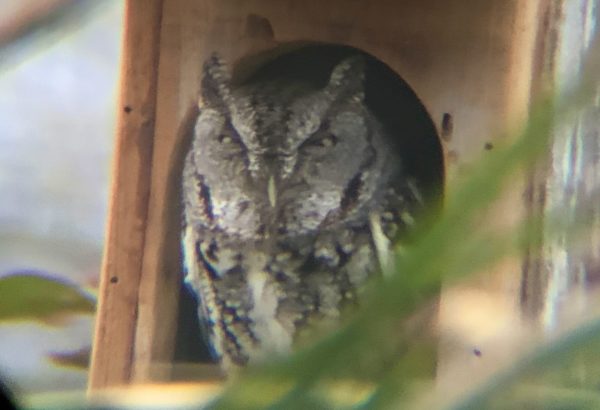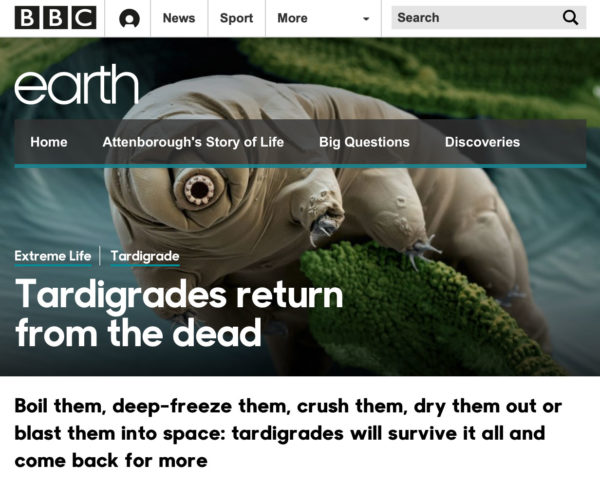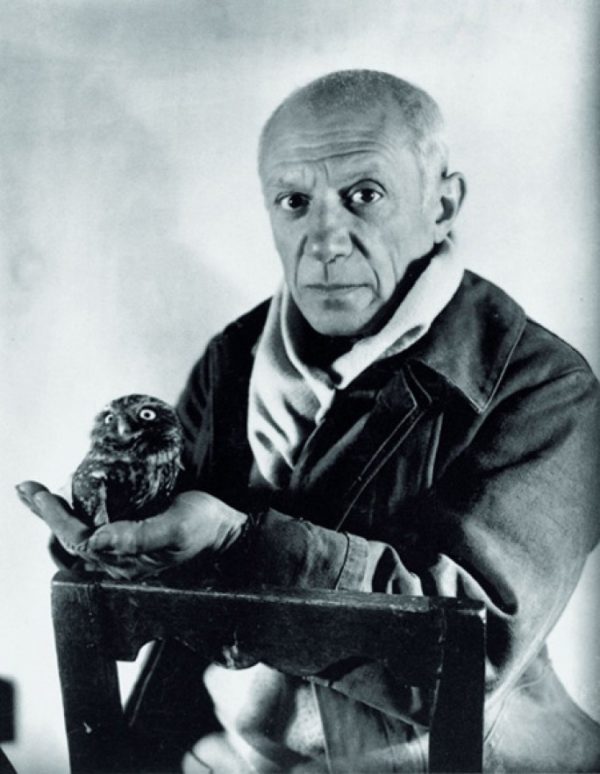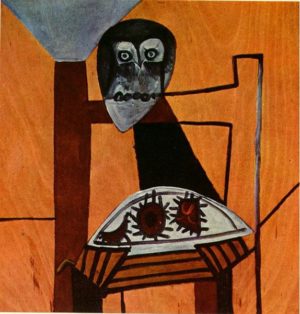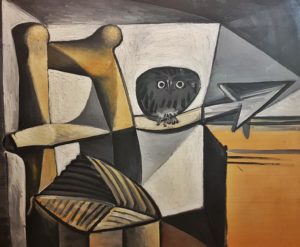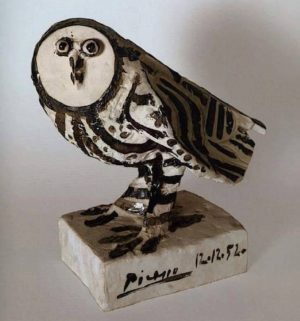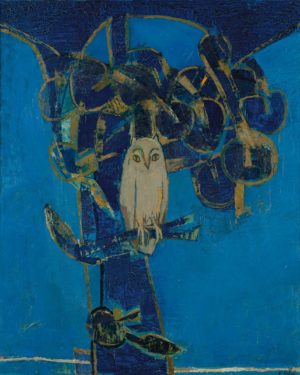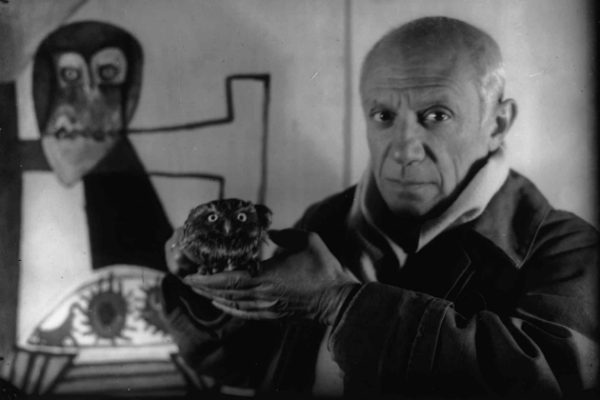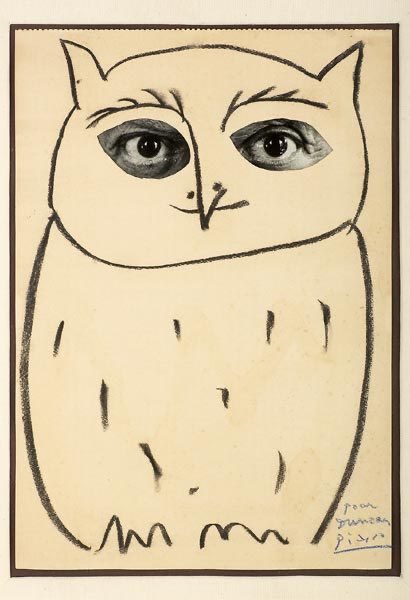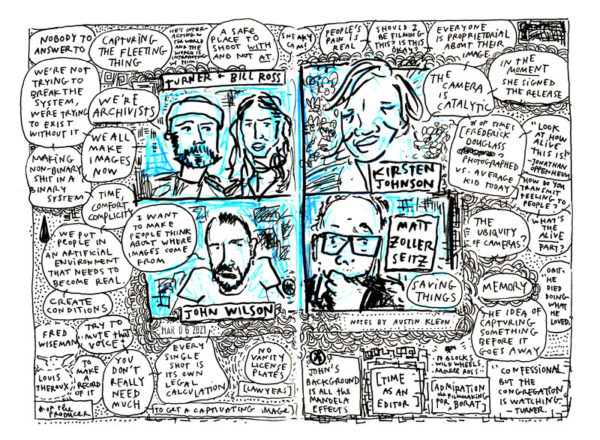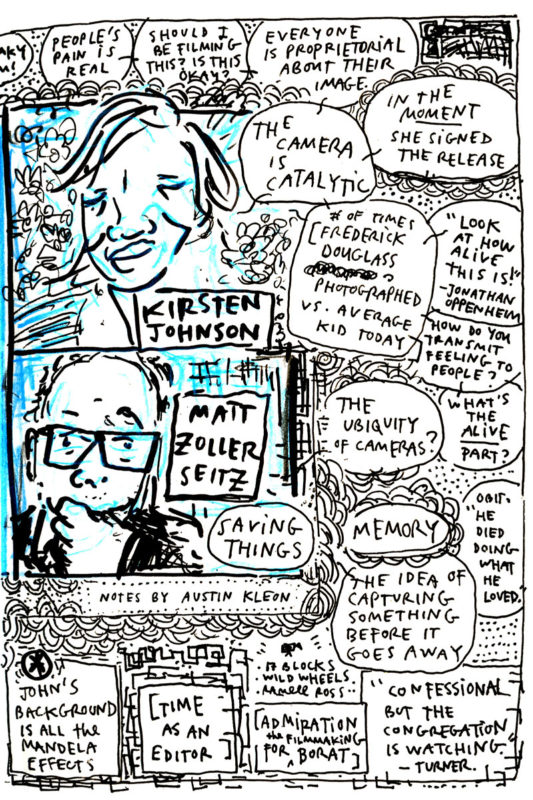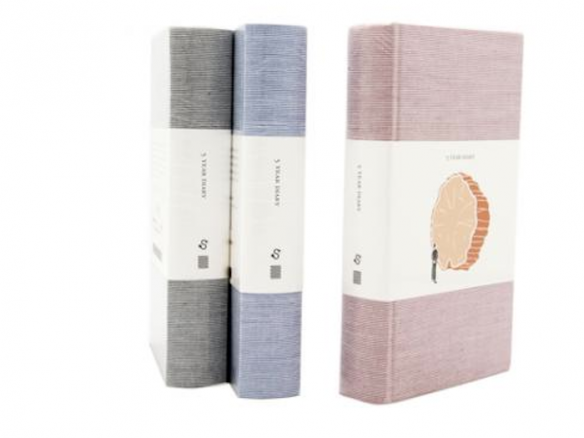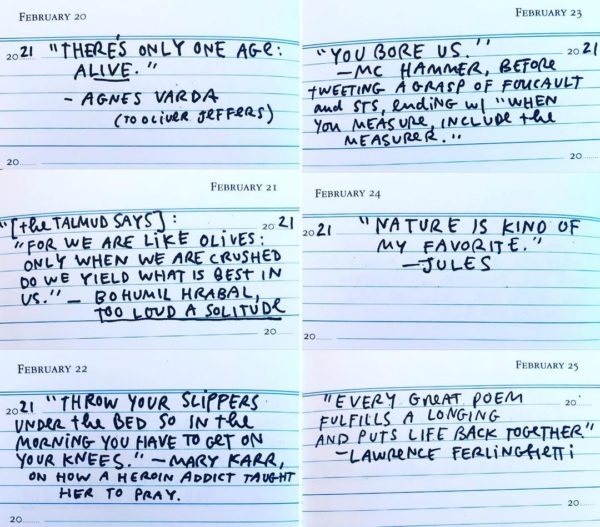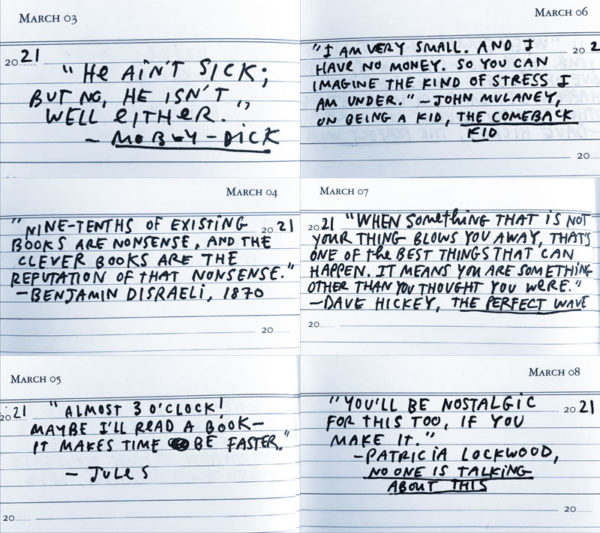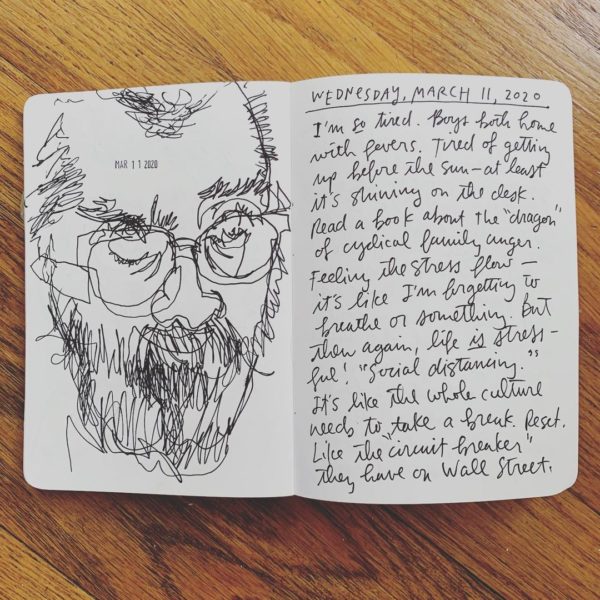
Not sure what possessed me, but yesterday I posted my diaries from the first week of our plague year — Wednesday, March 11, 2020 to Wednesday, March 18, 2020 — on Instagram. I’m transcribing some of them here, for whatever reason. Mostly for myself. No edits, except a few for privacy reasons, but I did add a few links.
At the time, I started each entry (usually 3-5 pages) with a blind contour drawing. You’ll notice in several of the entries I ask myself what was the “best thing” yesterday, a technique I learned from Nicholson Baker about cheerful retrospection. I always write in the morning about whatever happened the day before, something I got from David Sedaris. And because someone will inevitably ask, here’s the notebook and pens I use.
* * *
Wednesday, March 11, 2020
I’m so tired. Boys both home with fevers. Tired of getting up before the sun — at least it’s shining on the desk. Read a book about the “dragon” of cyclical family anger. Feeling the stress flow — it’s like I’m forgetting to breathe or something. But then again, life is stressful! “Social distancing.” It’s like the whole culture needs to take break. Reset. Like the “circuit breaker” they have on Wall Street.
It was a good thing for me to learn a craft with a true maker. It may have been the best thing I have done. Nothing we do is better than the work of handmind. When the mind uses itself without the hands it runs the circle and may go too fast, even speech using the voice only may go too fast. The hand that shapes the mind into clay or written word slows thought to the gait of things and lets it be subject to accident and time.
(From “Stonetelling,” in Ursula K. LeGuin’s Always Coming Home (via Alan Jacobs.)
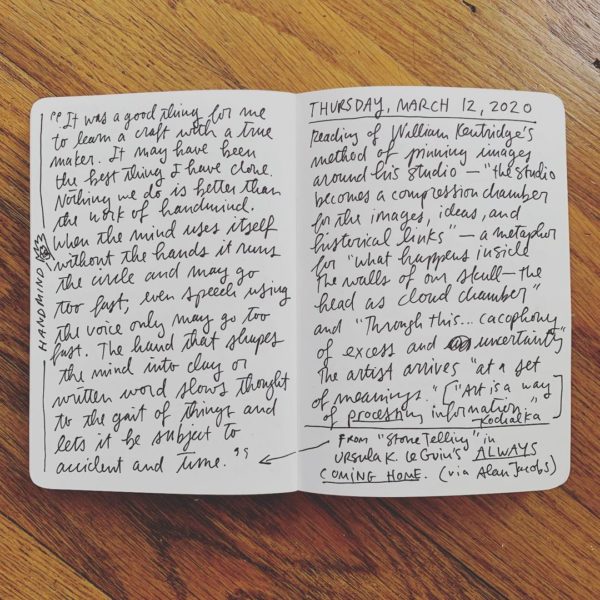
Thursday, March 12, 2020
Reading of William Kentridge’s method of pinning images around his studio — “the studio becomes a compression chamber for the images, ideas and historical links” — a metaphor for “what happens inside the walls of our skull — the head as cloud chamber” and “Through this… cacophony of excess and uncertainty the artist arrives “at a set of meanings.” [“Art is a way of processing information.” —Kochalka]
We do this all day now—our head is full of unsynthesized and UNPROCESSED images. It would be like swallowing several meals of Burger King without a digestive system. (New metaphor…) We have all the DERANGEMENT of the artist w/o the crucial step of meaning-finding w/o the handiwork.
(A crucial point is that Kentridge selected and arranged the images himself — they were not pushed at him via feeds.)
Again, the switch here would be to become intentional about all this — to trim the inputs more and then STOP the flow of images at a certain point so that you can process and synthesize them. We do all this taking in and very little letting out. We’re full up, as if poisoned, and there needs to be the occasional blood-letting. (Another option: stop the flow of externally produced images completely.)

Friday, March 13, 2020
It’s hard not to feel like a real cosmic event is occurring — as if everyone is bombing their brains with so much information that it’s impossible not to find meanings, ie, “conspiracy theories.”
Meg and Owen and Jules have been running fevers and hacking for a couple days now — I’ve been mostly symptom-free, but that might change at any moment — spring is springing outside — Owen noticed the tree out the tiny window above the bookcase was getting leaves. The bluebonnets are out — patches in yards. The oak + mold are high, which makes it hard to know what’s wrong with you. It’s just warm enough that we have to run the air-conditioning, which is never good for anyone’s cough. I can always tell who isn’t feel well by the level of non-problems they’re causing.
We’ve kept the boys home for two days — they canceled school today. Grocery stores are slammed. We’ll probably be home for at least two weeks. Strange to think about.
There’s nothing they can do for you Coronavirus-wise anyways, except for fluids and oxygen while your body fights it off. My worry is that Owen gets pneumonia though and we can’t get to the doctor or we can’t get him meds.
I’m trying to focus on what will make the day better — I sense a great letting go — if you have extremely low expectations… Hopefully we can just make art and listen to music and relax. But I don’t know how it’ll go.
Fluids. Fluids. Fluids.
You can sense that the culture, on the whole, is exhausted. It’s sort of a relief to just cancel all obligations. In the meantime, the pandemic is exposing just how fake and corrupt and hollow our institutions really are. I need to read Rebecca Solnit’s A Paradise Built in Hell, about how ppl respond in disasters.
It does seem like such a thing is possible: a little paradise, or a little, smallest viable utopia, in the middle of hell.
“I wish the government was as reassuring as the HEB website,” Meg said.
Gloomy out. Truly a Friday the 13th if ever there was one.
[11:36 AM] Back from our walk. Owen coughed the whole time and Jules listened to The Gashlycrumb Tinies on repeat.
Things are grim. Owen keeps playing this minor key song he’s working on over and over.
Jules won’t eat the ramen I made him.
Deep breaths. Deep, deep, deep breaths.
Making us a schedule to stick to.
Washing my hands so much they are dried + cracked.
Family yoga?

Saturday, March 14, 2020
[ Gould’s “Goldberg variations” with his weird humming]
This [drawing] was truly blind, done with my glasses on top of my head, couldn’t really draw my hair or my chin because I’m so blind… I like it.
Owen is laid out — he looks bad — he’s just not a robust kid. You look at his little arms. He said his teeth were chattering last night. Meg’s fever is broke — both boys running low grade 100 [degree] fevers, but Jules is in better spirits. Need to just keep them calm. and rest, rest, rest.
Amazed I haven’t gotten laid out yet. But no fever yet.
Yesterday on our walk, Jules + Owen hacked the whole time and Jules requested “The Gashlycrumb Tinies” on repeat. That night, he said, “Goodbye,” instead of “good night.”
Owen says his stomach hurts — his anatomy books lead him to self-diagnose his appendix. (Web MD.)
The germaphobe + hypochondriac in me is taking quite a beating.
The irony of all this is that we made (2) big life decisions in the past year (1) stop hoarding (2) send our kids to school so they don’t drive us crazy.
The universe has a sense of humor, for sure.
I’m thinking of Dougal Robertson’s line: “If any single civilized factor in a castaway’s character helps survival, it is a well-developed sense of the ridiculous. Laughter. Helps…
I was reading about the plague in Shakespeare’s time: how he wrote his sonnets — how they were a relief to have minus the theater money.
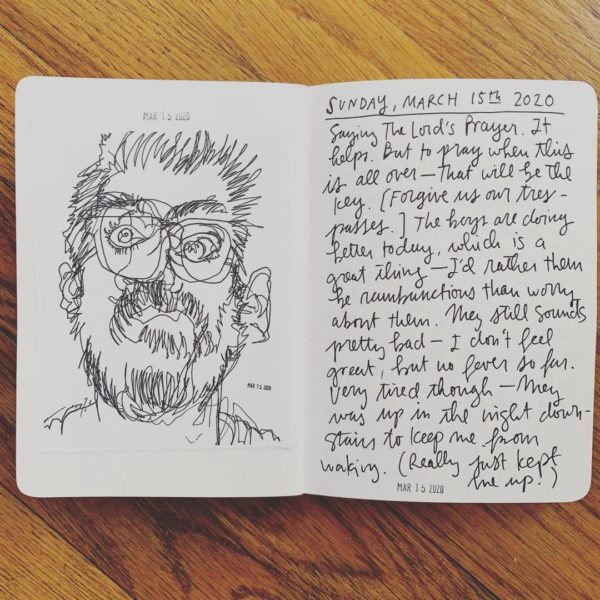
Sunday, March 15, 2020
Saying the Lord’s Prayer. It helps. But to pray when this is all over — that will be the key. [Forgive us our trespasses.] The boys are doing better today, which is a great thing — I’d rather them be rambunctious than worry about them. Meg still sounds pretty bad — I don’t feel great, but no fever so far. Very tired though — Meg was up in the night downstairs to keep me from waking. (Really just kept me up!)
I had a strange feeling today that actually this is how I’d prefer my days to be — nothing to prepare for travel wise, no social obligations, the city is nice and quiet…
And I have a sense of purpose — keep everybody in the house going, but stick to what works — make art. And it can be things that seem frivolous — in fact, it feels like the more frivolous the activity, the better it turns out!
To add to my feeling something cosmic is happening — it’s the Ides of March. This is, traditionally, the time of year that I sort things out for myself — pick a project to keep me busy for the rest of the year. Thank god this wasn’t the year I was to be on book tour! And thank god we aren’t [redacted]. Life is so much different than it was a year ago. We knew something was gonna happen + better to be where we want to be…
THE BEST THING YESTERDAY: Making dumb zines and listening to a Mary Ruefle podcast. Just sitting in the studio and vibing just like I’m doing now.
Man, I love the smell of a sharpened pencil.
I love how cool and rainy it is outside.
I love how Mary Reufle talked about reading, not to remember — cutting out marginalia + hanging it in her house.
[Just heard 10cc’s “Worst band in the world” and goddamn Dilla’s “Workinonit” is a piece of genius.]
SPACE TO FILL, YOU SAY?
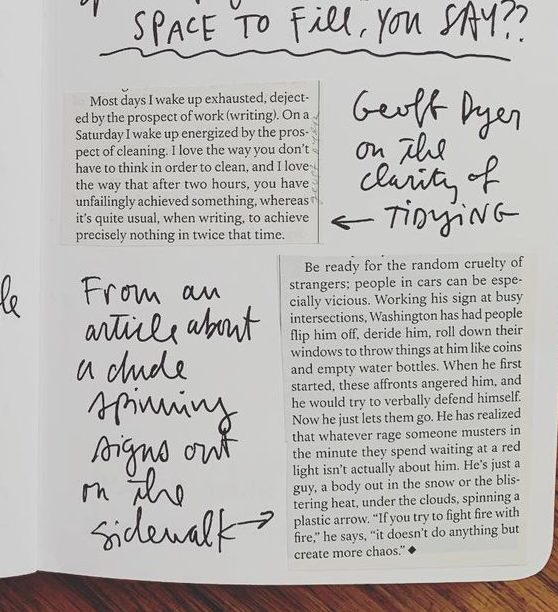

Monday, March 16, 2020
THE BEST THING YESTERDAY: I went off on a zine-making tear and at tub time I finished making these “Song Birds.” (Presented here in the order they showed up. God, that’s it, isn’t it? What kind of mindset it takes to just show up in the studio and ask, “What wants to show up today?” “What wants to show up today?” That’s the only real question.
[I’m listening to a 1974 Megamix and it’s half awesome and half horrible.] I could see these little zines showing up in a book like this — almost as a kind of art book — what if it was like an art book catalog for the art made in this house, 2015-2020. KLEONS 2015-2020. Ha! The “limitations of our personalities” are starting to show up around here.
I have an idea for another zine that I’m going to try when I get done writing here — that’s my new thing — don’t wait on an idea to grow stronger — once you have an idea, just start trying too make it appear — in the process of making the thing it’ll show you what it wants to be, I think. Better to take any signal and run with it.
In some ways, this time is a huge relief — we know what we’re supposed to do. “Stay home and make, art, not friends.” (Thinking of Mary Ruefle saying what a huge relief it is when your biological family passes on.)
I’ve learned, too, that I like working in miniature. I like working on small pages.
SMALL ART GETS BIG.
Instagram is exactly the place to show these little domestic pieces of making.
I long for the homebound and homespun.
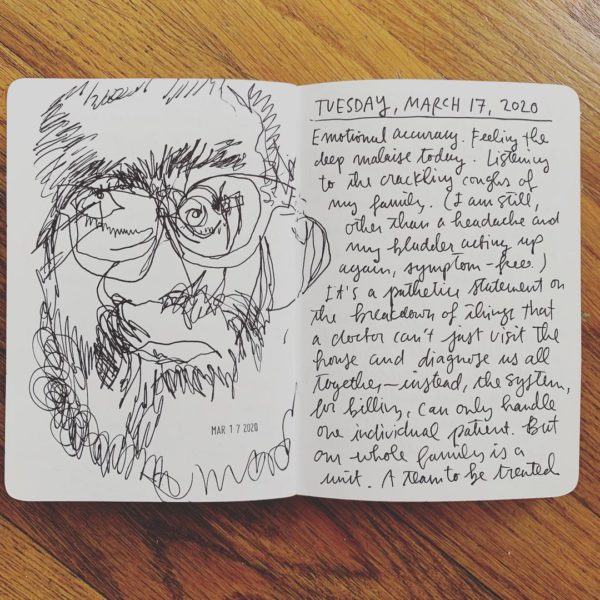
Tuesday, March 17, 2020
Emotional accuracy. Feeling the deep malaise today. Listening to the crackling coughs of my family. (I am still, other than a headache and my bladder acting up again, symptom-free.) It’s a pathetic statement on the breakdown of things that a doctor can’t just visit the house and diagnose us all together — instead, the system, for billing, can only handle one individual patient. But our whole family is a unit. A team to be treated.
[ Kraftwerk – “Autobahn” ]
Ok, THE BEST THING yesterday: probably the zines and Camus. Somebody online told me how much my work is helping them — I usually err on the side of words in a blog post — but my words, in my poems, in my cut-ups, seem much more helpful to me certainly, and maybe to others, too? But art, and poetry, they are there for you when you need them, that is for sure…
Today: Go for a walk. Make a zine. Stay positive. Be supportive. Let the light in. Drink coffee. Stay away from booze. Drink tea. Go ahead and do your pushups.
Take this time to read the classics — finish Camus’s The Plague — pull William James off the shelf. Read Mary Ruefle. Think of her puttering around the house, never touching the doorknob, just flittering from one thing to the next, attacking books with her trusty pot of White-Out…
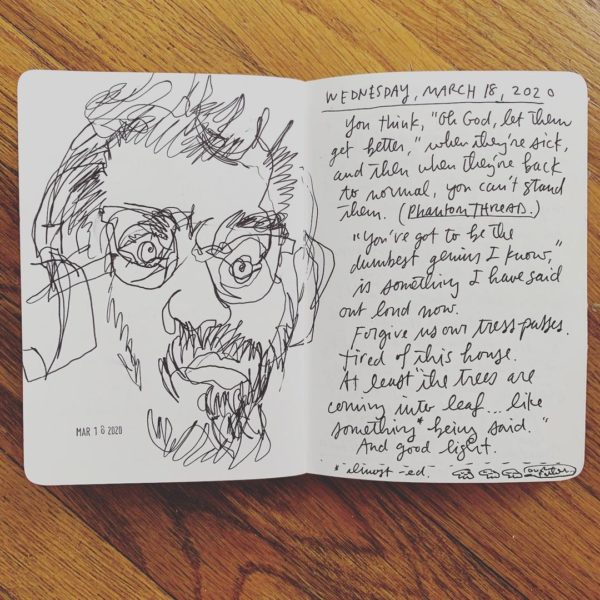
Wednesday, March 18, 2021
You think, “Oh god let them get better,” when they’re sick, and then when they’re back to normal, you can’t stand them. [Phantom Thread.]
“You’ve got to be the dumbest genius I know,” is something I have said out loud now.
Forgive us our trespasses.
Tired of this house.
At least “the trees are coming into leaf… like something almost being said.”
And good light.
* * *
Read more of my diaries.


